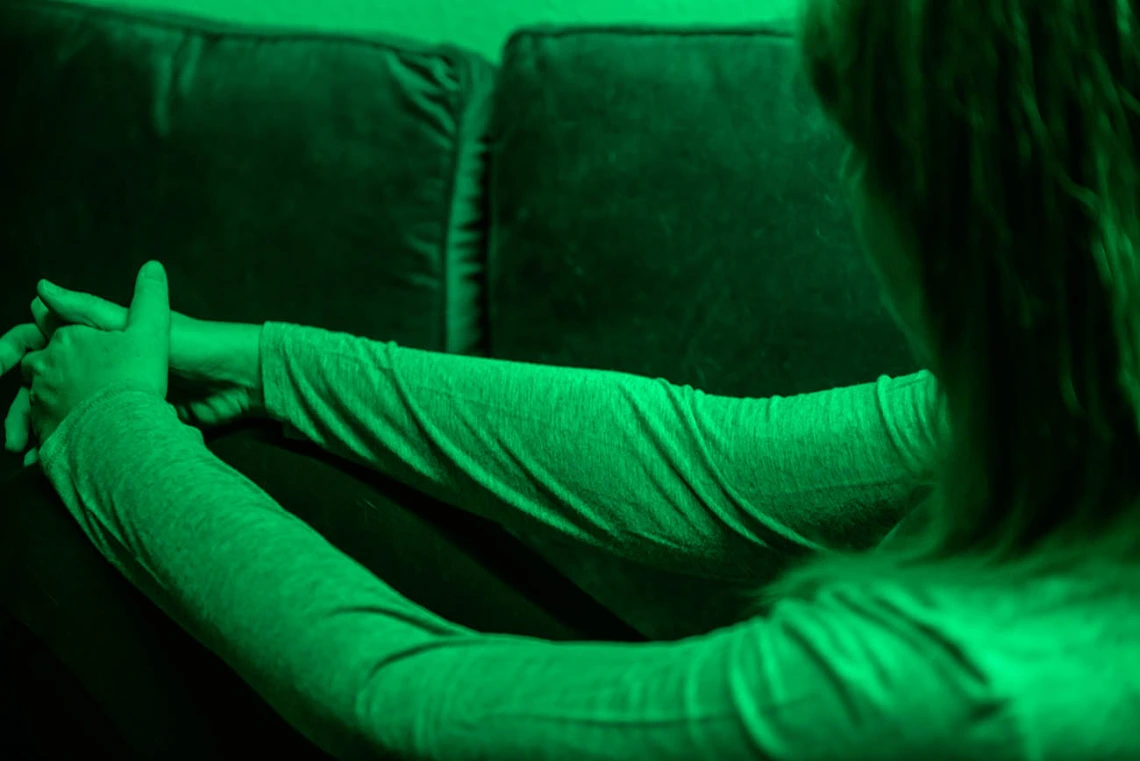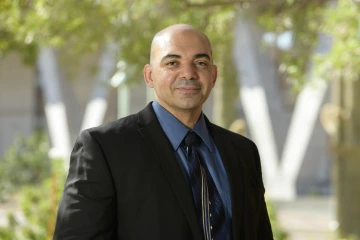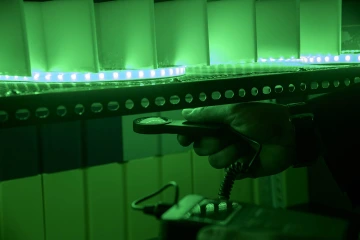Casting a green light on fibromyalgia, the invisible disease
People with fibromyalgia may have another treatment option available soon thanks to continuing research at the Comprehensive Center for Pain and Addiction.

Researchers at the University of Arizona Health Sciences are exploring green light therapy as a potential treatment option for people with fibromyalgia, a puzzling disease that affects approximately 10 million people — mostly women — in the U.S.
Chronic widespread body pain. Moderate to extreme fatigue. Sleep disturbances. In the late 1800s, patients with those symptoms were diagnosed with muscular rheumatitis or neurasthenia, conditions physicians struggled to treat. Today, those same symptoms – plus cognitive difficulties, or “brain fog,” and sensitivity to touch, light, and sound – may result in a diagnosis of fibromyalgia, the treatment of which still challenges doctors today.

Mohab Ibrahim, MD, PhD, is an internationally recognized pain researcher whose works has found green light to be a viable complement to opioids for the management of chronic pain in some people.
Fibromyalgia is one of several invisible diseases – chronic conditions with debilitating pain and fatigue symptoms that can’t be easily recognized just by looking at someone. It affects an estimated 10 million people in the U.S., according to the National Fibromyalgia Association, the majority of which are women.
“We really do not understand the pathophysiology of fibromyalgia,” said Mohab Ibrahim, MD, PhD, associate director of medical affairs at the University of Arizona Health Sciences Comprehensive Center for Pain and Addiction and professor of anesthesiology at the UArizona College of Medicine – Tucson. “There are some theories and hypotheses, and we are getting closer, but we are not there yet. So, because we don’t really understand why some people develop fibromyalgia and why others don’t, we try to manage the symptoms associated with it.”
One of the innovative treatments Ibrahim is researching is green light therapy. It is safe, noninvasive, and has already yielded positive results in pilot clinical trials for fibromyalgia patients and those with chronic migraine.
From bedside to bench
The phrase “from bench to bedside” is commonly used to describe the process of taking research from the laboratory to a clinical setting where it can benefit patients. As a physician-scientist, Ibrahim is in a unique position to let his clinical practice drive his research – from bedside to bench.

Assistant professor Laurent Martin, PhD, has been a key contributor to Ibrahim’s investigations into green light therapy.
“The way I designed my research is to answer questions I’m struggling with in the clinic. If I have a situation where it is very hard to manage a condition, that’s what I ended up researching in the lab to come up with solutions,” Ibrahim said. “That is one of the ways we came up with green light, because it was very hard to manage fibromyalgia and migraine.”
Ibrahim is a pain management physician who sees patients, including those with fibromyalgia, at the Banner – University Medical Center Chronic Pain Management Clinic in Tucson, Arizona. His goal is to improve the lives of each of his patients without the use of opioids, which come with a host of negative side effects.
“We like to explore nonpharmacological methods first because they come with minimal side effects. One of the most common and effective first-line therapies to address fibromyalgia is aerobic exercises, where people might not necessarily do something intense, but they do enough to get their heart rate up and sweat a little bit,” Ibrahim said.
Other treatments might include over-the-counter nonsteroidal anti-inflammatory drugs, prescription pain medications such as gabapentin, muscle relaxers, sleep aids and psychiatric care.
But sometimes, none of it helps.
Pilot trials, promising results
From 2016 to 2019, 21 people with fibromyalgia who were out of traditional treatment options completed a pilot clinical study to test the effectiveness of green light therapy. Each study participant was given two LED light strips – one white, one green – and instructed how to use the lights: white for 10 weeks, followed by green for 10 weeks.
"I have another tool in my toolbox to treat two of the most difficult conditions – migraine and fibromyalgia."
Mohab Ibrahim, MD, PhD
Participants were asked to use the lights in a dark room with no other light source for a minimum of one hour every day, with the option to increase to two hours daily. They were encouraged to stay awake – no sleeping! – and engage in activities such as writing, reading or listening to music, that did not require an additional light source. Activities that introduced other light sources, such as watching television or using a smartphone, were discouraged.
Each participant filled out surveys throughout the study to document how they were feeling. The results were astounding.
“Their pain improved; their quality of life improved,” said Ibrahim, who was assisted in the research by Laurent Martin, PhD, who started in Ibrahim’s laboratory as a postdoctoral researcher and is now an assistant professor of anesthesiology in the College of Medicine – Tucson.
Specifically, participants reported an average reduction in average pain intensity from 8.4 to 4.9 on the 10-point numeric pain scale when using green light compared with white light. Participants also reported improvements in pain frequency, duration of pain episodes; ability to fall asleep and stay asleep, ability to work, exercise, and do household chores; and overall quality of life.

Green light therapy is economical and can be done at home using an LED light of the appropriate wavelength and intensity. Clinical trial participants used the lights for 1-2 hours per day for 10 weeks, after which many reported a reduction in pain intensity, duration and frequency, and improvements in several other categories including quality of life.
The results mimicked Ibrahim’s first pilot clinical trial of green light therapy for chronic migraine. In that study, green light exposure reduced the number of headache days per month by an average of about 60%. Participants noted that green light exposure resulted in a 60% reduction in pain, from 8 to 3.2. Green light therapy also shortened the duration of headaches, and improved participants’ ability to fall and stay asleep, perform chores, exercise, and work.
For Ibrahim, the results are intriguing, both as a researcher and as a doctor.
“I wear two hats: scientist and physician. The scientist in me says this is a great finding, but this is where the story begins,” Ibrahim said. “I am really interested in how this works because if I understand the mechanism, then I can utilize it for other conditions. That's the scientist part. The clinician in me thinks, this is really exciting! I have another tool in my toolbox to treat two of the most difficult conditions – migraine and fibromyalgia.”
Yet he tempers his enthusiasm with a healthy dose of reality. There are many more questions to be answered about green light therapy, including how it works. To that end, Ibrahim has already published papers that explain the physiological mechanisms of green light therapy for acute, post-surgical pain. His lab continues to study how greet light therapy influences the chronic pain of fibromyalgia or migraine.
“Whenever someone asks me about green light therapy, I always say this is experimental,” Ibrahim said. “I like to put the brakes on a little bit, even on my own excitement, because I never want to give false hope. What I can tell you is that the preliminary data is very, very encouraging.
Our Experts
Mohab Ibrahim, MD, PhD
Professor of Anesthesiology, College of Medicine – Tucson
Associate Director of Medical Affairs, Comprehensive Center for Pain and Addiction
Director, Chronic Pain Management Clinic
Program Director, Pain Medicine Fellowship
Professor, Pharmacology, College of Medicine – Tucson
Professor, Neurosurgery, College of Medicine – Tucson
Member, Clinical and Translational Oncology Program, UArizona Cancer Center
Laurent Martin, PhD
Assistant Professor, Anesthesiology, College of Medicine – Tucson
Contact
Stacy Pigott
UArizona Health Sciences
520-539-4152
spigott@arizona.edu

